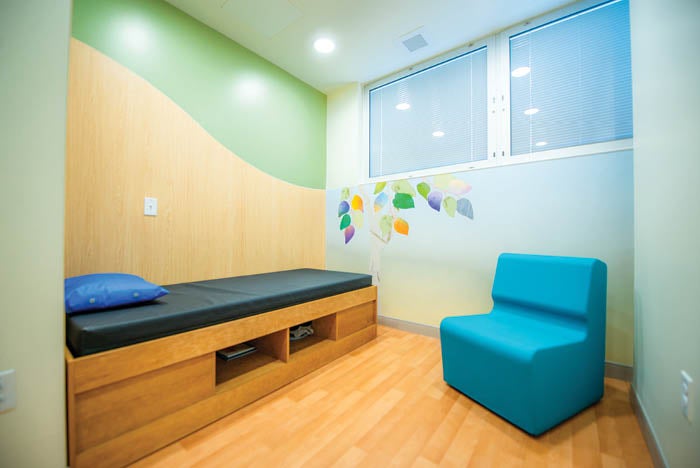Safeguarding against ligature risks

This mental health unit includes anti-ligature features.
Image courtesy of ASHE
The concern for suicide safety has recently become a hot topic with accrediting organizations such as The Joint Commission.
For instance, along with many Environment of Care (EC) requirements, The Joint Commission added National Patient Safety Goal (NPSG) 15.01.01, Reduce the risk for suicide, effective July 1, 2019, which is a catchall for suicide risk in alignment with the CMS conditions of participation 482.13(c)(2), which states, “The patient has the right to receive care in a safe setting.”
NPSG 15.01.01, Element of Performance (EP) 1, states, “The hospital conducts an environmental risk assessment that identifies features in the physical environment that could be used to attempt suicide; the hospital takes necessary action to minimize the risk(s) (for example, removal of anchor points, door hinges, and hooks that can be used for hanging).” This should be of particular interest to the hospital facility manager.
A closer look at this issue can help demystify some of the confusion surrounding suicide risk as well as the Centers for Medicare & Medicaid Services (CMS) requirements and help provide a safe environment for the patients and communities that health care facilities serve.
Revealing stats
A study conducted by The Joint Commission entitled “Incidents and Method of Suicide in Hospitals in the United States” and published in the November 2018 edition of The Joint Commission Journal on Quality and Patient Safety revealed some intriguing facts as summarized by Megan Knowles in a Sept. 12, 2018, article on the website of Becker’s Hospital Review titled “5 Stats on Hospital Suicide”:
- “ The finding that about 49 to 65 hospital inpatient suicides happen annually in the U.S. is far lower than the widely cited estimate of 1,500 each year, the Joint Commission said. Of these suicides, 75% to 80% were among psychiatric inpatients.
- The study found estimated suicide rates were 3.2 per 100,000 psychiatric inpatient admissions and 0.03 per 100,000 non-psychiatric inpatients.
- In both databases, hanging accounted for over 70% of suicides.
- About half of suicides occurred in a hospital bathroom, one-third in a bedroom and the remainder in a closet (4%), shower (4%) or other location (8%).
- The most commonly used fixture point was a door, door handle or door hinge (53.8%).”
As demonstrated from this study, hanging is the most frequent method of suicide. Hanging can be accomplished by simply having an object such as rope, string, bedsheet or any other material that can be formed into a loop and wrapped around the neck. This can cause stricture to the vessels of the neck by attaching the object to an anchor point and applying pressure by means of weight.
Typically, hanging is not accomplished in the traditional sense, involving a noose used to suspend the entire weight of the body by the neck; more commonly, it is accomplished by attaching the object to an anchor point such as exposed plumbing, faucets and doors and just sitting down or “alligator rolling” to create enough pressure to cause stricture.
“It takes approximately 11 pounds (5 kilograms) of pressure to compress the carotid artery; 4.4 pounds (2 kilograms) for the jugular veins and at least 15 kilograms (33 pounds) for the airway,” according to an entry on Wikipedia. “The amount of time it takes to lose consciousness and die is difficult to predict accurately and depends on several factors. Some believe unconsciousness occurs in 5 seconds.”
Assessing spaces
The most common areas for ligature-related suicide to occur are where the patient is left alone for periods of time such as in their rooms at night, in the bathroom and in areas where staff have limited direct line of site of the patient. Thorough screening of the patient is required by NPSG 15.01.01 EPs 2-7 to assess the likelihood of self-harm.
“The level of precautions necessary depends on the staff’s knowledge of the patient’s intentions regarding self-harm and the amount of supervision the patient will have while using that part of the facility,” according to the Behavioral Health Design Guide, Edition 9.0, by Behavioral Health Facility Consulting LLC. Bed placement in correlation with staff visibility and frequency of rounding can help mitigate the opportunity for a patient to inflict harm to themselves.
A thorough and complete environmental safety risk assessment must be conducted and documented to identify and help guide plans to mitigate suicide associated risk.
As described in the Behavioral Health Design Guide, the lowest areas of risk (Level 1) are areas where patients are not allowed and the highest level of risk (Level 4) are areas where patients spend a great deal of time alone with minimal or no supervision.
When conducting the initial risk assessment, not only do potential anchor points need to be assessed, but other objects that may provide a means for self-harm or may be weaponized to harm others need to be included in the assessment. Additionally, the potential for barricading should be addressed.
A careful and thorough plan must be developed prior to conducting the risk assessment. Each room, bathroom, corridor, public gathering area, showering facility or any other area that patients may occupy needs to be assessed individually and thoroughly. Health facilities professionals should treat each room or area individually and not collectively; never assume that every room is identical.
When assessing an area, facilities professionals should start in one corner of the space and work their way around the area systematically and methodically. They should begin at the entryway and systematically examine from ceiling to floor faceplates, electrical outlets, paint, screws, the type of glass, objects that can be easily removed, medical gas connections, ports for medical devices, nails that can be picked loose, and any other object that could potentially be removed and used to inflict self-harm or be weaponized to harm others.
Facilities professionals should repeat this process for every occupiable space. They should pay particular attention to doors, door hardware and door swing. They should examine corridors and public areas in the same fashion, noting the ceiling grid type and objects suspended from the ceiling such as exit signs, communication devices, cameras and fire alarm beacons. They also should note all alcoves and areas in which a patient can potentially hide.
Design considerations
Once the assessment has been completed, the data must be analyzed and ranked according to levels of risk to determine priority for purchasing ligature- and tamper-resistant materials and developing a mitigation plan. Cost of compliance cannot be considered a reason for purchasing suboptimal materials. If the space is currently occupied, careful consideration must be given for planning and commissioning the renovation.
Another challenge associated with environmental safety risk is aesthetics.
“Behavioral health units and facilities are preferred to be designed to appear comfortable, attractive, relaxing and as residential in character as possible. The focus on patient and staff safety has often pushed the aesthetics of these units toward the appearance of a prison environment,” according to the Behavioral Health Design Guide. “To better meet the needs of patients, the final design must avoid an institutional look while meeting the array of applicable codes and regulations and addressing the therapeutic and safety needs of patients and staff. These no longer need to be either/or trade-offs. Both safety and therapeutic environment are possible in a well-designed facility that has a noninstitutional appearance that is correct for the unique conditions that exist in each facility.”
Special consideration must to be given to security and controlled access. Fortunately, the 2012 edition of NFPA 101®, Life Safety Code®, provides some leeway for patients whose clinical needs require specialized security or who may pose a security threat. Chapter 18 (new construction) and Chapter 19 (existing construction), sections 2.2.2.5.2 when all the following requirements of 2.2.2.6 are met, provide specific guidance, including:
- Provisions shall be made for rapid removal of occupants by means of one of the following: Remote control locks, keying of all locks to keys carried by staff at all times and other such reliable means available to the staff at all times.
- Only one locking device shall be permitted on each door.
- More than one lock shall be permitted on each door, subject to approval of the authority having jurisdiction.
Doors often are a considerable challenge for behavioral health suites.
Not only do they provide a means for barricade if the door swings into the room, but they also present many anchor points for ligature-associated harm. Every component of the door must be assessed. Continuous hinges are required as well as anti-ligature door hardware.
Special consideration must be given to patient room bathroom doors as patients spend time alone in their rooms. There are many options available for this including Velcro tear-away doors and sliding doors.
One option found in many Veterans Affairs (VA) inpatient mental health units “utilizes a standard swinging door with the top of the door cut at a 30-degree angle or greater to prevent the top of the door being used as an anchor point,” according to the VA. This door type also has a 3-inch gap between the door and frame to prevent the latch side from being used as an anchor point.
Besides construction costs, there are many additional costs for consideration. Operational costs can far exceed the first costs of construction. Typically, staff is the most expensive operational component. A well-designed facility can greatly improve staff fatigue and employee retention. Design must also be done with flexibility on the forefront.
“Rigidity must give way to flexibility to serve patients who present with varying diagnoses that manifest into individual and unique behavioral issues,” according to an article in BWBR Architects Inc.’s 2017 white paper on “Investing in Behavioral Health for Better Outcomes.” “Coupled with diverse age groups and gender cohorts as well as unpredictable census volumes on a day-to-day basis, the operations of a behavioral health unit demand a space that can flex with the daily flow.”
Behavioral health units are a particular challenge and can be quite costly to renovate or construct in such a way that meets all the requirements of NPSG 15.01.01, EPs 1 and 2. The key to creating a safe environment for behavioral health patients is in the risk assessment and a thoroughly formulated mitigation plan derived from the risk assessment.
Other areas outside of the behavioral health unit for consideration are the emergency department and medical-surgical units where a patient with an elevated risk for suicide may be placed.
“Effective July 1, 2020, National Patient Safety Goal (NPSG) Standard NPSG.15.01.01 will apply to Joint Commission-accredited critical access hospitals,” stated the December 2019 Joint Commission Perspectives newsletter. “Because rates of death by suicide are very high in rural communities, The Joint Commission determined that this NPSG also should apply to critical access hospitals.”
Very important role
Because these are relatively new requirements, there is a lot of difficulty, confusion and expense in designing or redesigning health care facilities to provide a safe, yet inviting, environment to aid in treating behavioral health.
Facilities professionals who are charged with the safety and security of patients, visitors and staff have a very important role in staying abreast of the ever-evolving requirements and applying them to their unique environments to provide an atmosphere that is both aesthetically pleasing and functionally free of elements that provide opportunities for patients seeking to harm themselves.
The advice provided in this article gives health facilities professionals a basic foundation from which to build out a program that addresses the needs of their unique facilities.
Stephen Cranford, CHFM, CHSP, is director of environment of care and safety at Baptist Health – Fort Smith in Arkansas. He can be reached at stephen.cranford@baptist-health.org.




